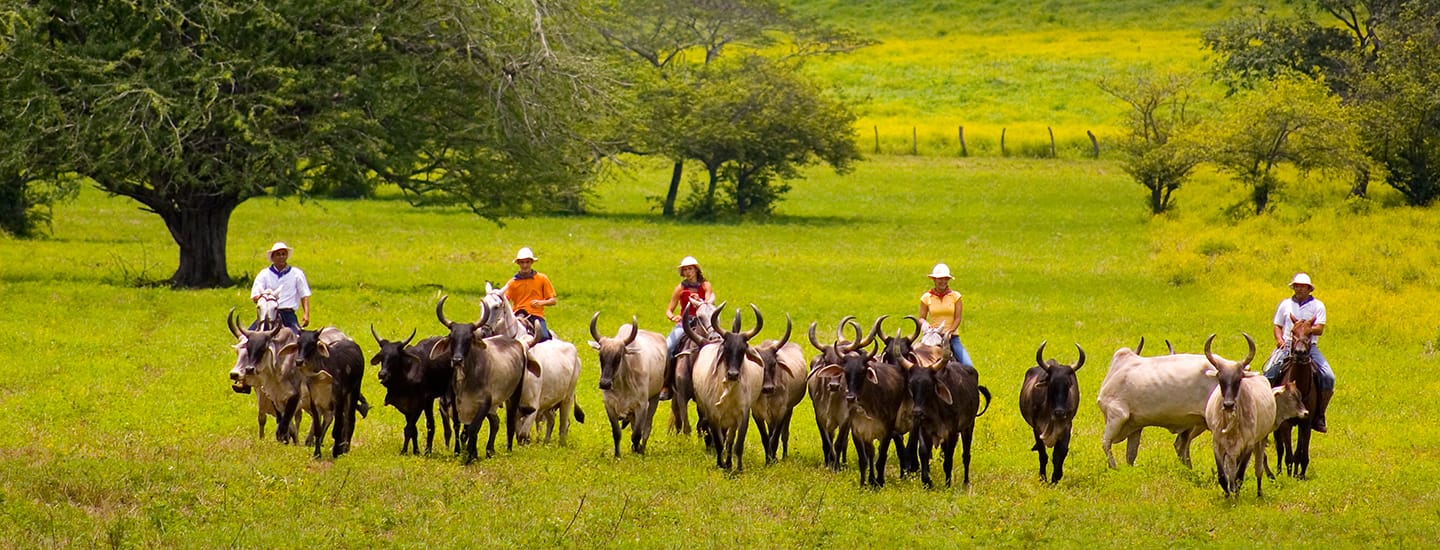
Cultural manifestations
in Guanacaste
Cultural manifestation in Guanacaste
Guanacaste is famous for its music, and its musicians are well respected. . Along with music, traditional dances from Guanacaste have been preserved over time and are heavily influenced by Andalusian Flamenco (Spain). Some of the traditional dances include “El Punto Guanacasteco,” “Los Amores de Laco,” “La Cajeta,” “La Flor de Caña,” “El Torito,” “El Zapateado,” “El Pavo,” and “La Botijuela,” among others. Corn is an important crop in Guanacaste. There are many typical dishes derived from this product: Guanacaste tortillas, tanelas, tayuyas, tamales (Costa Rican style), pisque, sweet tamal, corn rice, nacatamales (Nicaraguan style), rosquillas, bizcochos, pozol, chicheme, chichia, pinol, among others. The people of Guanacaste also produce beverages, like el pinol, from finely ground white corn that is toasted on a ceramic plate. “La chicha de maiz” is a beverage prepared in different ways depending on the region of Costa Rica. In Guanacaste, it is made by browning and grinding corn, then adding plenty of pallaston (roughly ground corn), panela, and ginger. It is stored in ceramic jars and left to ferment for two or three days. “El chicheme” is a nutritious and popular drink for parties and church gatherings. It is a hot corn drink that is left to ferment naturally, then sugar, ginger, water and ground cloves are added.
You can find these popular dishes and beverages in busy areas like markets in Liberia, Nicoya, and the famous Women’s Cooperative in Santa Cruz.
Colonial church in San Blas
This beautiful church is located in the center of the town of Nicoya and it is located on the same site where the first parish was established in Costa Rica in 1544. Inside is a small historical/religious museum. Next to the church is a beautiful city park, which serves as a meeting place. Patronage festivals are celebrated every year on December 15.
Santo Cristo de Esquipulas patronage festival
The Christ image in the town of Santa Cruz was brought from Guatemala in 1840. The celebration goes through different stages: During “La Vispera” (The Eve) on January 13, a statue representing the Christ of Esquipulas is carried from Arado to a house in the outskirts of Santa Cruz, where it is prepared for the next day, when the Christ image is carried through the streets and adorned with palm trees branches, malinche flowers, and colorful ticker tape.
January 15 is the Patron Saint Day, which is celebrated by a procession through Santa Cruz, made up of Promesano indigenous people, the Traditional National Queen and her court, the local priest and devotees. There is a mass held in the church in honor of the saint. On January 14 through the 18, there are traditional dances, Marimba and typical Guanacaste music, plays, poetry readings, “retahilas” (tirade) and “bombas” (traditional folkloric songs). Along with these events, local arts and crafts and souvenirs related to these Santa Cruz festivities are available for purchase.
Nuestra Señorita La Virgen de Guadalupe Festival ·La Yeguita·
The Virgen de Guadalupe festival is a series of celebrated events occurring between November 1, the “contadera de dias” (the Countdown), through December 12, La Virgen de Guadalupe Day.
This final day begins at dawn. At 9 a.m. a mass is held prior to a procession followed by the traditional “La Yeguita” dance. That evening, a ceremony is held for the new staff members of the Brotherhood the following year. This meeting is held in the local Brotherhood residence. When electing new members, the women, not the men, are the ones who vote.
Santa Cruz
Santa Cruz is the heart of national folklore, due to its keen interest in maintaining traditions and customs. There is a cozy and well-maintained park, and the city offers a variety of commercial and public services. There are a variety of natural tourist attractions including beautiful beaches like Ostional, Blanca (Flamingo), Tamarindo, and Grande.
Nicoya
According to studies, Nicoya is one of the oldest cities in the country and the heart of the Chorotega ethnic group. The layout of the city is well organized with parks, a catholic church, and various commercial sites, such as the local market where local food and beverages are sold. It is located 400 ft. above sea level and over the years has seen much urban development.
July 25th celebrations
On this date, the annexation of Nicoya from Nicaragua to Costa Rica in 1824 is celebrated. This day is a national holiday, but is more celebrated throughout Guanacaste, particularly in Nicoya and Liberia.
Arts and crafts from Guaitil and San Vicente
The locals from Guaitil de Santa Cruz and San Vicente de Nicoya (towns with more than 5,000 years of traditional ceramic work), create beautiful ceramics from clay with traditional techniques learned from the Chortega indigenous people who once lived in this area. Ornaments, jars, flower pots, vases, plates, ocarinas (a musical instrument), are just a small sampling of what they produce. This beautiful tradition is passed down from family to family, and even taught in the elementary school in Guaitil. Here, students learn the techniques to create beautiful pieces that are later purchased by visitors.
